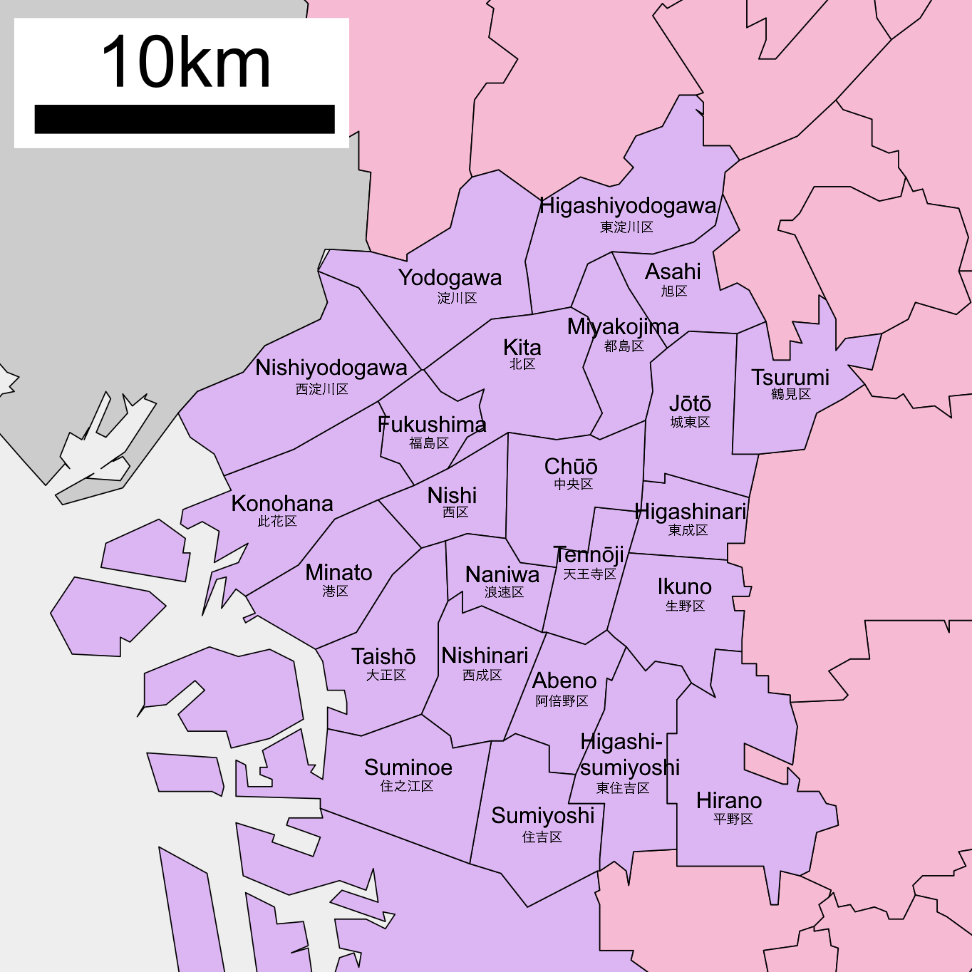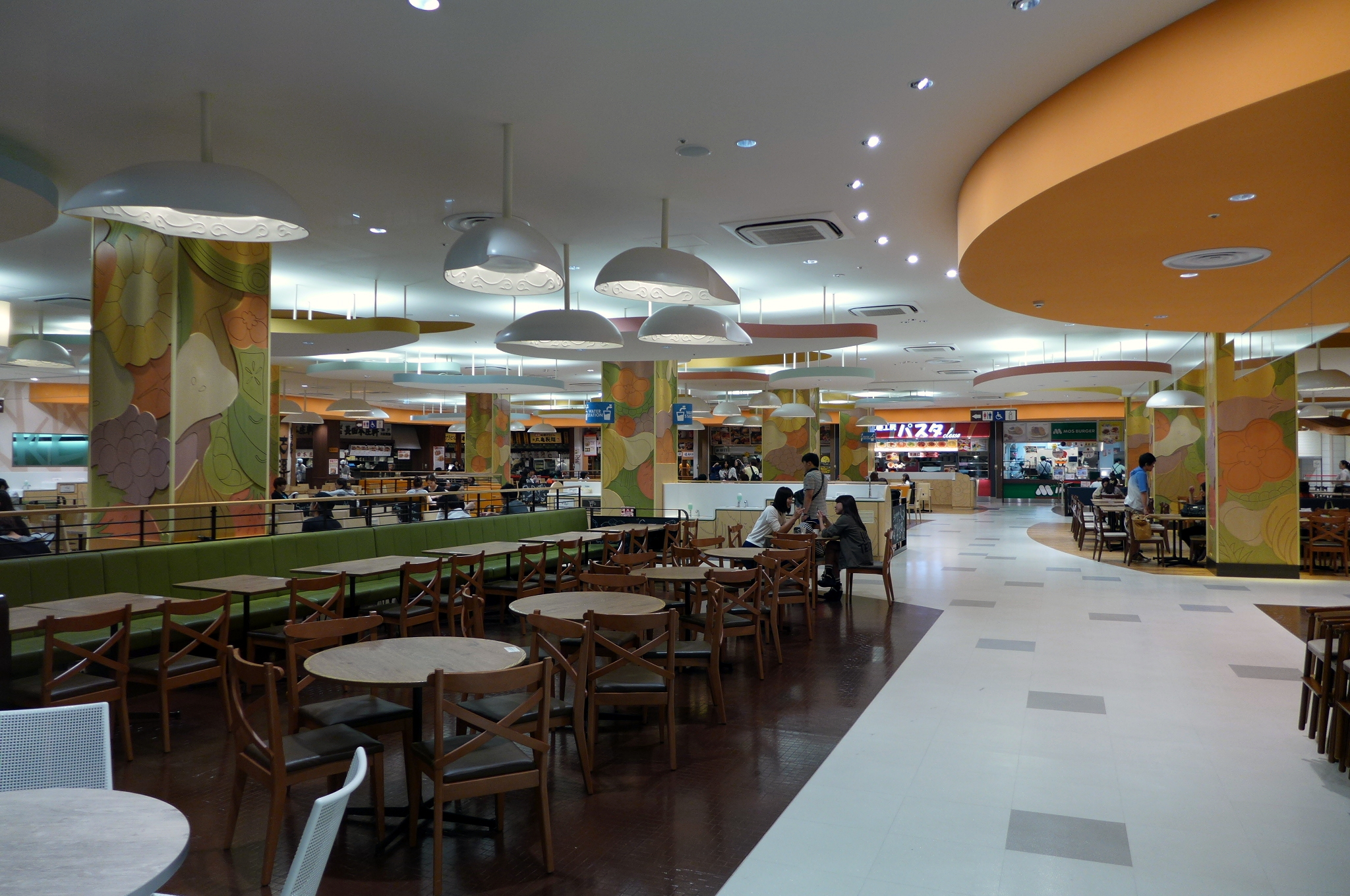|
ŇĆsaka Abenobashi Station
is a railway station on Kintetsu Minami Osaka Line in Abeno-ku, Osaka, Japan. The station is also called "Abenobashi Station" („Āā„ĀĻ„Āģś©čťßÖ). According to the research on November 13, 2012, 159,075 passengers got on and off trains at ŇĆsaka Abenobashi Station. It was the largest number of passengers getting on and off trains at stations on the Kintetsu Lines. The west ticket gates of the station were shifted 35 m to the east on March 20, 2009, so that station facilities are entirely within the Kintetsu Abeno department store's "new" (east) building. The "old" (western) portion was demolished to make way for a new high-rise building. Connecting lines * Tennoji Station **West Japan Railway Company (JR West) *:*Osaka Loop Line *:*Hanwa Line *:*Yamatoji Line **Osaka Metro *:* Midosuji Line (M23) *:*Tanimachi Line (T27) * Tennoji-eki-mae Station **Hankai Tramway Uemachi Line Layout The station has six bay platforms serving five tracks on the first floor. ;Minami-Osaka L ... [...More Info...] [...Related Items...] OR: [Wikipedia] [Google] [Baidu] |
Abeno-ku, Osaka
is one of 24 wards of Japan, wards of Osaka, Japan. It is located in southern Osaka city and has a population of over 107,000. In the northern part of Abeno, Abenobashi, there is the Kintetsu Minami Osaka Line which terminates at Abenobashi Station, the MidŇćsuji Line and Tanimachi Line of the Osaka Municipal Subway at Tennoji Station, and the Hankai Tramway's Uemachi Line which terminates at Tennoji-eki-mae Station. The Abenobashi area of Abeno is a commercial area where department stores and movie theatres are located. Abeno is a home for Sharp Corporation (Nagaike-cho). History When Osaka city increased its number of wards from 15 to 22 on April 1, 1943, Sumiyoshi-ku, Osaka, Sumiyoshi ward was divided into three "new" wards, one of which was Abeno, the others being Higashi-Sumiyoshi ward and Sumiyoshi ward. There are varying theories as to the origin of the name "Abeno". One is that it was the name of a powerful family-clan in ancient Japan, another suggests it might come fr ... [...More Info...] [...Related Items...] OR: [Wikipedia] [Google] [Baidu] |
Hankai Tramway
is a company which owns two tramway lines in the cities of Osaka and Sakai, Osaka, Japan. It was originally a subsidiary of Nankai Electric Railway Co., Ltd. although it still uses the Nankai symbol as its logo. History Hankai Tramway Co., Ltd. was founded in 1910. In 1915, the company merged with the Nankai Railway which runs both north and south in Osaka. The city's overall tram network was once extensive. As motorization developed as an alternative form of transportation along with the construction of subway lines underneath major routes, the trams lost their passengers, causing Osaka's once-extensive tram network to shrink, with only the Hankai and Uemachi tram lines remaining. By 1980, the company split from Nankai. However, Hankai still uses the Nankai symbol as its logo despite this. Lines Current * Hankai Line (Ebisucho - Hamadera eki-mae) 14.1 km * Uemachi Line (Tennoji eki-mae - Sumiyoshikoen) 4.6 km The lines use standard gauge tracks and are electrifie ... [...More Info...] [...Related Items...] OR: [Wikipedia] [Google] [Baidu] |
Namba
Namba (, ) is a district in ChŇęŇć and Naniwa wards of Osaka, Japan. It is regarded as the center of Osaka's ''Minami'' ( :ja:„Éü„Éä„Éü, "South") region. Its name came from a variation of '' Naniwa'', the former name of Osaka. Namba hosts some of the city's main south-central railway terminals, as JR, Kintetsu, Nankai, Hanshin, and three Osaka Metro subway lines all have stations within this region. Railway stations ; Namba Station : Nankai Electric Railway :: Nankai Line :: Koya Line : Osaka Metro :: MidŇćsuji Line (M20) :: Yotsubashi Line (Y15) :: Sennichimae Line (S16) ; JR Namba Station :JR West :: Kansai Main Line (Yamatoji Line) ; ŇĆsaka Namba Station : Kintetsu :: Namba Line (through service to the Nara Line) : Hanshin Railway ::‚óŹ Hanshin Namba Line References {{Authority control Tourist attractions in Osaka ChŇęŇć-ku, Osaka Naniwa-ku, Osaka ... [...More Info...] [...Related Items...] OR: [Wikipedia] [Google] [Baidu] |
Osaka Station
is a designated city in the Kansai region of Honshu in Japan. It is the capital of and most populous city in Osaka Prefecture, and the third-most populous city in Japan, following the special wards of Tokyo and Yokohama. With a population of 2.7 million in the 2020 census, it is also the largest component of the Keihanshin Metropolitan Area, which is the second-largest metropolitan area in Japan and the 10th- largest urban area in the world with more than 19 million inhabitants. ŇĆsaka was traditionally considered Japan's economic hub. By the Kofun period (300‚Äď538) it had developed into an important regional port, and in the 7th and 8th centuries, it served briefly as the imperial capital. Osaka continued to flourish during the Edo period (1603‚Äď1867) and became known as a center of Japanese culture. Following the Meiji Restoration, Osaka greatly expanded in size and underwent rapid industrialization. In 1889, Osaka was officially established as a municipality. The con ... [...More Info...] [...Related Items...] OR: [Wikipedia] [Google] [Baidu] |
Fuse Station
is an interchange passenger railway station located in the city of HigashiŇćsaka, Osaka Prefecture, Japan, operated by the private railway operator Kintetsu Railway. Lines Fuse Station is served by the Osaka Line, and is located 4.1 rail kilometers from the starting point of the line at ŇĆsaka Uehommachi Station. It is also the nominal terminus of the Nara Line and is 26.7 kilometers from the opposing terminus at Kintetsu Nara Station. Station layout The station has four levels; the first two levels are Kintetsu Department Store, the third level is for the Osaka Line, and the fourth level is for the Nara Line. There is an island platform serving 2 tracks between 2 passing tracks each on the third level and the fourth levels. ;3rd level ;4th level Adjacent stations Bus ;North :Osaka Municipal Transportation Bureau (Fuse-ekimae) :*Route 12 for :*Route 86 for :Osaka Bus Co., Ltd. (Higashi-Osaka Fuse) :*for Kyoto :*for Nagoya :*for Tokyo ;South :Kintetsu Bu ... [...More Info...] [...Related Items...] OR: [Wikipedia] [Google] [Baidu] |
Osaka City Bus
is a designated city in the Kansai region of Honshu in Japan. It is the capital of and most populous city in Osaka Prefecture, and the third-most populous city in Japan, following the special wards of Tokyo and Yokohama. With a population of 2.7 million in the 2020 census, it is also the largest component of the Keihanshin Metropolitan Area, which is the second-largest metropolitan area in Japan and the 10th- largest urban area in the world with more than 19 million inhabitants. ŇĆsaka was traditionally considered Japan's economic hub. By the Kofun period (300‚Äď538) it had developed into an important regional port, and in the 7th and 8th centuries, it served briefly as the imperial capital. Osaka continued to flourish during the Edo period (1603‚Äď1867) and became known as a center of Japanese culture. Following the Meiji Restoration, Osaka greatly expanded in size and underwent rapid industrialization. In 1889, Osaka was officially established as a municipality. The cons ... [...More Info...] [...Related Items...] OR: [Wikipedia] [Google] [Baidu] |
ShitennŇć-ji
ShitennŇć-ji (, ''Temple of the Four Heavenly Kings'') is a Buddhist temple in ŇĆsaka, Japan. It is also known as Arahaka-ji, Nanba-ji, or Mitsu-ji. The temple is sometimes regarded as the first Buddhist and oldest officially administered temple in Japan, although the temple complex and buildings have been rebuilt over the centuries, with the last reconstruction taking place in 1963. Shortly after World War II, ShitennŇć-ji became independent of the parent Tendai sect and formed the Wa sect (''wa-shŇę'', ) of Buddhism. History Prince ShŇćtoku was known for his profound Buddhist faith when Buddhism was not widespread in Japan during the 6th century. In order to popularize Buddhism, Prince ShŇćtoku led a massive national project to promote Buddhism and he commissioned the construction of ShitennŇć-ji. Prince ShŇćtoku invited three Korean carpenters from Baekje. They brought knowledge and led the construction of ShitennŇć-ji. The commission of ShitennŇć-ji was part of a massive ... [...More Info...] [...Related Items...] OR: [Wikipedia] [Google] [Baidu] |
Osaka Municipal Museum Of Art
The is a museum located in TennŇćji Park, TennŇćji-ku, Osaka, Japan. The museum focuses on Japanese and east Asian art. Collection File:Katsushika Hokusai - Shell Gathering - Google Art Project.jpg, Hokusai, Shell Gathering, 19th century File:Mi Fu - Calligraphy in Grass Script - Google Art Project.jpg, Mi Fu, Calligraphy in Grass Script, late 11th century File:Gong Suran - Ming Consort Leaving the Country - Google Art Project.jpg, Gong Suran, 12th-13th century File:šļĒśėüšļĆŚćĀŚÖęŚģŅÁ•ěŚĹĘŚõĺ.jpg, The Five Stars and 28 Heavenly Abodes, Zhang Sengyou, Liang dynasty (5-6th century) Access * Osaka Municipal Subway ** Midosuji Line, Tanimachi Line: Tennoji Station *JR West **Yamatoji Line, Osaka Loop Line, Hanwa Line: Tennoji Station * Kintetsu ** Minami Osaka Line: Osaka Abenobashi Station Notes External links Official Web site [...More Info...] [...Related Items...] OR: [Wikipedia] [Google] [Baidu] |
Abeno Cues Town
is the name of in Abeno-ku, Osaka, Japan. Overview Abeno Cues Town consists of and . Via Abeno Walk is the area for the local tenants, and Q's Mall is the area the specific architect, Tokyu Land Corporation, manages. The area opened on April 26, 2011. This shopping area is connected to Tennoji Station operated by Osaka Metro by the underground passage. The area is connected to the pedestrian bridge (pre-opened on February 1, 2012, and completed on April 24, 2013) via the Abeno A1 Area Urban Redevelopment Project A1-2 Building (Abeno nini) opened on February 1, 2012 along with the elevated walkway between Cues Town and Abeno nini. The other passage was opened on March 15, 2014 to connect to Abeno Station on the Osaka Metro Tanimachi Line. Access *Osaka Metro: Tennoji Station ( Midosuji Line, Tanimachi Line), Abeno Station (Tanimachi Line) *JR West: Tennoji Station (Yamatoji Line, Osaka Loop Line, Hanwa Line) * Kintetsu Minami Osaka Line: Osaka Abenobashi Station * Hankai Ue ... [...More Info...] [...Related Items...] OR: [Wikipedia] [Google] [Baidu] |
Kintetsu Department Store
is a department store chain in the Kansai region, Japan. It is headquartered in Abenosuji Itchome, Abeno-ku, Osaka, Japan. History *January, 1920: was opened in front of Kyoto Station. *February, 1920: was founded. *1926: opened its own restaurant at Daiki Building in Uehommachi, Osaka. *1930: Kyoto Bussankan General Partnership opened branch store in Yanagase, Gifu. *September, 1931: Kyoto Bussankan General Partnership was renamed . *September 29, 1934: Marubutsu General Partnership was reorganised as . *1934: founded . *September, 1936: was opened in Uehommachi, Osaka. *November, 1937: Daitetsu Department Store was opened in Abeno, Osaka. *March, 1941: Daiki consolidated Sangu Kyuko Railway Company and was renamed , thus, Daiki Department Store was renamed . *April 1, 1944: Kankyu consolidated Daitetsu Department Store Company, thus, Kankyu Department Store was reestablished as and as . *June 1, 1944: Kankyu and Nankai Railway were consolidated to form . Kankyu Departmen ... [...More Info...] [...Related Items...] OR: [Wikipedia] [Google] [Baidu] |



